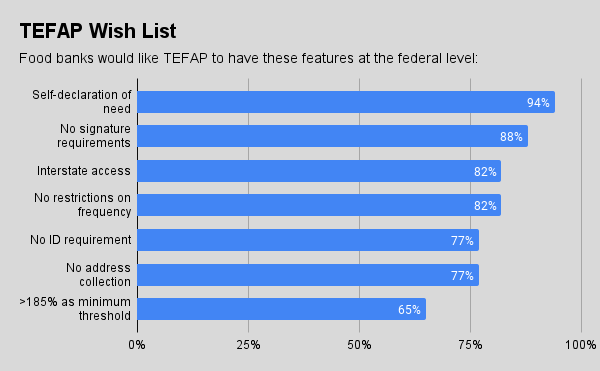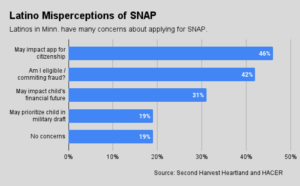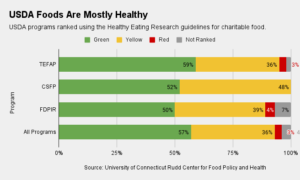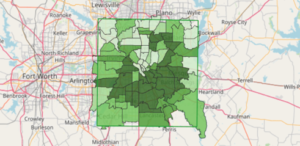The Capital Area Food Bank is one of only six food banks in the Feeding America network to serve three states, giving it a front-row seat into the multitude of ways the federal TEFAP program is administered across state lines.
The 40-year-old program, which distributes commodities grown on U.S. farms through food banks, gives states wide authority over many aspects of the program, including who can participate, how often, and what sorts of requirements they need to meet.
“It’s no more than ten lines of text that actually create the program, and the states have an ungodly amount of autonomy to create within that kind of framework,” noted Adam LaRose, Capital Area Food Bank’s Director of Advocacy and Public Policy.

The biggest consequence of TEFAP’s state-focused approach is inequitable access to the program across the country, according to a recent survey of 20 multi-state food banks undertaken by Capital Area Food Bank, with support from Feeding America.
For example, income requirements vary by state from 130% to 400% of the federal poverty guideline, creating complications for people who regularly cross state lines in their daily lives. In other disparities, most states require clients to have IDs and physically sign for their food, while others have no such requirement. Some states require clients to verify their income, while others allow them to self-declare their need.
As a federal program, TEFAP has four key requirements to determine eligibility, including name, number of people in the household, address, and a declaration of income. Food banks overwhelmingly would like to see legislation that would limit the ability of states to impose additional requirements.
The survey found that 94% of responding food banks would support federal action to allow for self-declaration of need without income guidelines, while 88% would support federal action to disallow signature requirements. “Food banks unanimously want to see clients have better access and more equity in how they take advantage of TEFAP,” LaRose said.
The report noted other challenges rooted in TEFAP’s state-based structure, such as difficulties in splitting orders across state lines. Other challenges include insufficient administrative funding to cover costs, and the high number and volume of cancelled orders. The report estimated that cancelled orders from January 2019 through March 2022 equated to an estimated 50 million meals that respondent food banks either couldn’t provide or had to acquire through purchasing or other sources.
“It’s not only about the interstate food banks that have multiple states in their service area,” LaRose said. “What we experience in administrative burdens, the client experience, ordering, cancellations, choice, input, we see in food banks that only serve in one state as well.”
Overall, LaRose said, food banks are eager to collaborate with state agencies and have greater input in how TEFAP operates in a variety of areas, including flexibilities for distributing food to partner agencies and TEFAP recipients. “Food banks want a little bit more of a seat at the table to have a say on how TEFAP is administered in conjunction with their states, not as directed by the states. The states have a lot on their plate, and food banks have been doing this for 40 years,” he said.
Food banks have “two really brilliant opportunities” on the horizon to define TEFAP’s future direction, LaRose said. One is the upcoming Farm Bill, and the other is a notice of proposed rule-making from USDA’s Food and Nutrition Service that will make access and parity improvement within several USDA food distribution programs, including TEFAP, CSFP for seniors, and FDPIR for Indian reservations. He expects proposed regulations later this summer.
LaRose credited Feeding America’s role as a “strategic thought partner” in conducting the survey. – Amanda Jaffe
Amanda Jaffe is a writer and former attorney with a deep interest in organizations and mechanisms that address food insecurity. In addition to Food Bank News, her essays and articles have been published in a number of print and online magazines and journals. Her writing may be found at www.amandajaffewrites.com.
Like what you’re reading?
Support Food Bank News
This article was made possible by the readers who support Food Bank News, a national, editorially independent, nonprofit media organization. Food Bank News is not funded by any government agencies, nor is it part of a larger association or corporation. Your support helps ensure our continued solutions-oriented coverage of best practices in hunger relief. Thank you!
Connect with Us:










